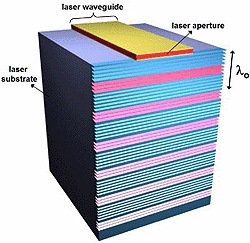THz rays (T-rays) can penetrate paper, clothing, plastic and many other materials, making them ideal for detecting concealed weapons and biological agents, imaging tumours without harmful side-effects, and spotting defects, such as cracks, within materials. THz radiation is also used for high-sensitivity detection of tiny concentrations of interstellar chemicals.
However, traditional systems for generating and detecting T-Rays are expensive, often costing in excess of £100,000.

Federico Capasso, from Harvard’s School of Engineering and Applied Sciences, said: ‘Unfortunately, present THz semiconductor lasers are not suitable for many of these applications because their beam is widely divergent — similar to how light is emitted from a lamp. By creating an artificial optical structure on the facet of the laser, we were able to generate highly collimated [tightly bound] rays from the device. This leads to the efficient collection and high concentration of power without the need for conventional, expensive, and bulky lenses.’
To get around conventional limitations, the researchers sculpted an array of sub-wavelength-wide grooves (dubbed a metamaterial) directly on the facet of quantum cascade lasers. The devices emit at a frequency of 3THz (or a wavelength of 100 microns) in the invisible part of the spectrum, called the far-infrared.
‘Our team was able to reduce the divergence angle of the beam emerging from these semiconductor lasers dramatically, while maintaining the high-output optical power of identical unpatterned devices,’ said Edmund Linfield from Leeds University’s School of Electronic and Electrical Engineering. ‘This type of laser could be used by customs officials to detect illicit substances and by pharmaceutical manufacturers to check the quality of drugs being produced and stored.’
The use of metamaterials — artificial materials engineered to provide properties that may not be readily available in nature — was critical to the researchers’ successful demonstration. While metamaterials have potential use in novel applications such as cloaking, negative refraction and high-resolution imaging, their use in semiconductor devices has been very limited to date.
‘In our case, the metamaterial serves a dual function: strongly confining the THz light emerging from the device to the laser facet and collimating the beam,’ said Nanfang Yu, postdoctoral fellow at Harvard. ‘The ability of metamaterials to confine strongly THz waves to surfaces makes it possible to manipulate them efficiently for applications such as sensing and THz optical circuits.’
The work by Leeds and Harvard was published in the 8 August issue of Nature Materials.





JLR teams with Allye Energy on portable battery storage
This illustrates the lengths required to operate electric vehicles in some circumstances. It is just as well few electric Range Rovers will go off...